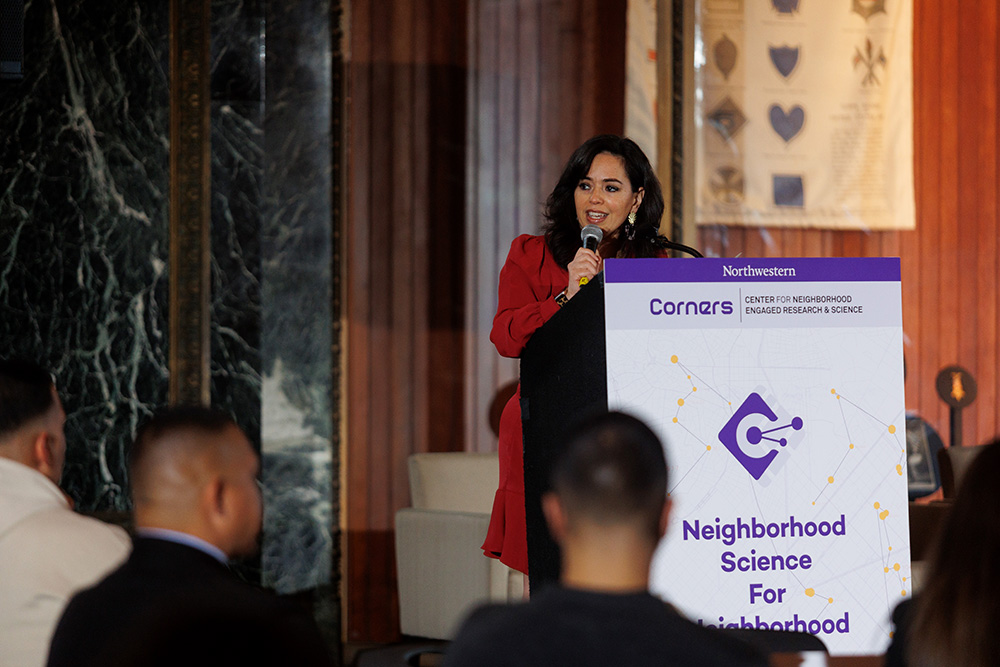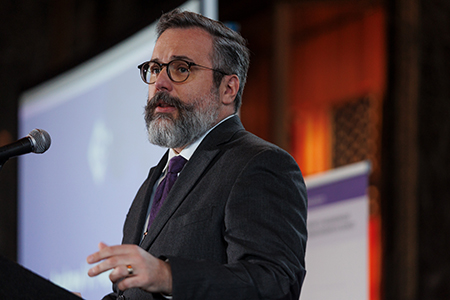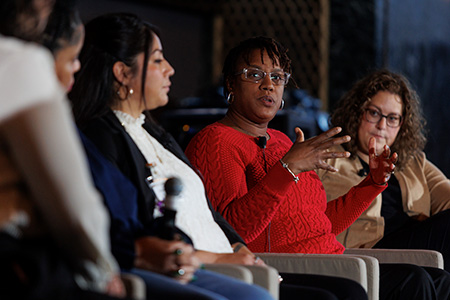'We Are Making the City Safer'
Corners previews promising evidence that community violence intervention and citywide partnerships can help prevent shootings
Get all our news
To us, Corners is more than an acronym. They are meeting places, places of opportunity, and openings where one can look for ways to solve social problems from different perspectives.”
Soledad McGrath
Corners Executive Director

Illinois State Senator Cristina Pacione-Zayas spoke about how crucial it is for participants to come together to stop gun violence at the symposium on community violence intervention on Dec. 15, 2022.
When three deadly mass shootings take place just days apart in California, or a six-year-old shoots his teacher, or 40 are shot in Chicago over one January weekend, it often feels like addressing the plague of gun violence is a hopeless effort.
Yet an approach centered on community violence intervention, or CVI, where trained interventionists reach out directly to connect with those most at risk for perpetuating the cycle of gun violence, points to a path forward.
At a December 15 event discussing CVI research and practices, IPR sociologist Andrew Papachristos pointed to citywide, neighborhood-level collaboration as preventing at least 383 homicides and shootings between 2017 and 2021.
“That’s 383 families that were spared the trauma and pain associated with homicides, and that is a big deal,” Papachristos told the 300 symposium attendees, many of whom are involved in CVI efforts in Chicago. “You should be proud of that number.”

Andrew Papachristos shares remarks during the opening
of Corners' December 2022 symposium.
Those efforts to curb gun violence are occurring across the city at the neighborhood level through a variety of community and civic partnerships such as Communities Partnering 4 Peace (CP4P) and Chicago CRED. Corners, the Center for Neighborhood Engaged Research & Science, of which Papachristos is its founder and faculty director, serves as the research partner for many of these efforts, and it organized the symposium.
Corners’ engaged research process—through which the team works closely with community and civic partners to collect and analyze a wide range of data on the complex networks of residents, institutions, and organizations—offers unique insights into the impact of these growing CVI efforts.
“We see renewed energy in terms of the partnerships and collaboratives developed over the last several years that many are starting to show real impact and promise,” Papachristos said following the event.
He encouraged those who only pay attention to the chilling counts of homicide victims to look beyond them to see the massive strides in building a “violence prevention infrastructure” with real potential.
“Many of these partnerships across the city are helping make Chicago safer,” Papachristos continued. “We are saving lives.”
In addition to Corners’ researchers at Northwestern and their colleagues, the symposium brought together interventionists, community leaders, and others involved in efforts to curb gun violence, as well as keynote speaker Arne Duncan, managing partner of the Emerson Collective and former U.S. Secretary of Education under President Barack Obama.
In his keynote, Duncan spoke about how the vast majority of violence in Chicago is not random.
“There is a story, multiple stories, behind almost every shooting,” Duncan said. “You just have to know the community to understand what's happening, to try and track that and stop the next one.”
To that end, Duncan praised the “vitally important work” of street outreach workers and the “extraordinary” partnership with Corners, which he says is bringing a new precision through their social network analysis of violence to work that is “life and death.”
And such life-and-death work cannot advance without committed community engagement.
Illinois Democratic State Senator Cristina Pacione-Zayas, District 20, spoke about how crucial it is for the symposium participants to come together as a community of practice to better understand and treat the root causes of the violence. And she underscored her commitment—and that of her colleagues in the Latino Caucus—to continuing the fight against gun violence in Chicago’s underserved and under-resourced communities.
“We will continue to bring our lived experiences because we come from the community, we come from social movements, we have been beneficiaries of these programs,” she said.
The unique approach of engaged research on gun violence and other social issues in tandem with invested community partners is what led Corners to change its name from N3: The Northwestern Neighborhood and Network Initiative in October.
“It better reflected our approach to research, and our values as a center and as a team,” Corners Executive Director Soledad Adrianzén McGrath explained.
“To us, Corners is more than an acronym,” McGrath continued. “They are meeting places, places of opportunity, and openings where one can look for ways to solve social problems from different perspectives.”
More Interest in Violence Intervention, but a Traumatized Workforce
One of the key components to running an effective community violence intervention rests on the shoulders of its civilian workers, who are typically recruited from the neighborhoods they serve. Duncan praised them for their courage and skill, calling them the “tip of the spear” to stem gun violence in Chicago.
“That work is vitally important. No one works harder or no one has a bigger heart, but our goal is never to be busy—our goal is to be effective,” Duncan said, “and so are we targeting the men and women most at risk of shooting and being shot.”
These CVI workers are typically the first on the scene to respond to a shooting or other incident of gun violence, and Corners researchers were part of a team that recently documented how this responsiveness and proximity to violence exacts a grueling toll.

The second panel focused on how women are impacted by gun
violence and CVI work in Chicago.
A recent landmark survey of the CVI workforce in Chicago reveals that 59% of CVI workers witnessed someone being shot at, and 32% witnessed a victim struck by gunfire. During work hours, 20% were shot at, and 2% were shot and wounded.
“The findings of these studies suggest that investment in community violence intervention should prioritize improving worker safety and reducing violent exposure while developing support for vulnerable frontline practitioners,” Papachristos said.
Published in Science Advances, the study provides a comprehensive look of at these “first responders” who play a pivotal role in violence prevention. Papachristos co-leads the Violence Intervention Workers Study (VIeWS). He wrote the article with lead author David Hureau of the University at Albany, SUNY, and others including leaders from Chicago CRED and the Office of Firearm Violence Prevention in the Illinois Department of Human Services.
In a separate study published in Preventive Medicine, the VIeWS research team used the study data to examine this indirect exposure to violence. They find Chicago CVI workers experienced symptoms of secondary traumatic stress—the stress stemming from working with traumatized populations—that was exacerbated by their exposure to violence in the workplace that is common in the profession.
In the second study, the authors show that nearly all interventionists reported at least one secondary traumatic stress indicator within seven days of taking the survey. They also reveal that workers who experienced the death of a client, witnessed a shooting, or were shot at themselves were more likely to be affected by secondary traumatic stress.
For Papachristos, the data and invigorating energy around CVI efforts and the unprecedented collaboration between researchers and community partners point to a tangible way to help resolve the issues around gun violence that plague not just Chicago, but other cities as well.
“I want to quote my favorite historian, Shermann ‘Dilla’ Thomas,” Papachristos said at the symposium referring to violence prevention efforts. “Everything dope comes from Chicago.”
Andrew Papachristos is professor of sociology and faculty director, and Soledad Adrianzén McGrath is executive director and research professor for Corners, the Center for Neighborhood Engaged Research & Science, housed within the Institute for Policy Research at Northwestern University.
Photos: L. McDermott
Published: January 26, 2023.


